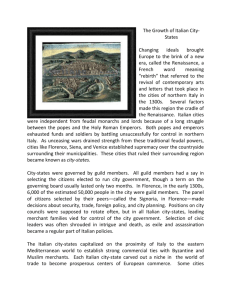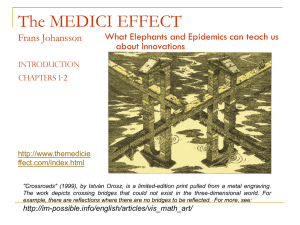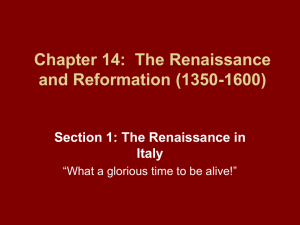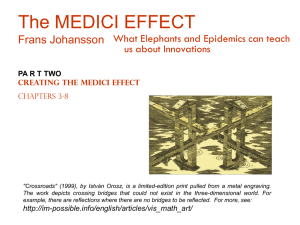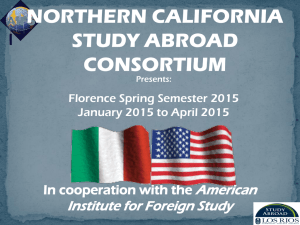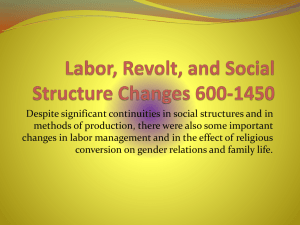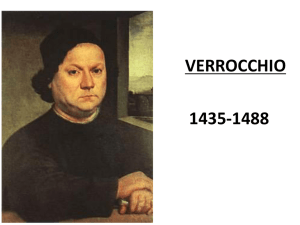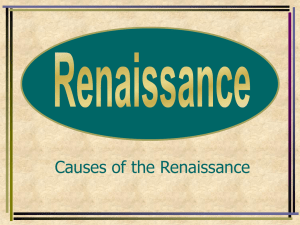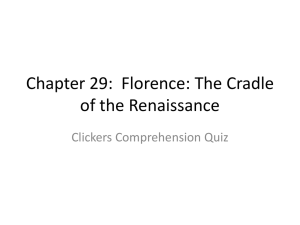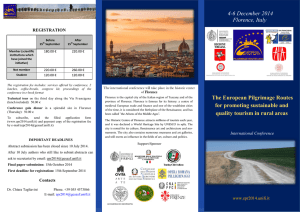Renaissance Italy
advertisement
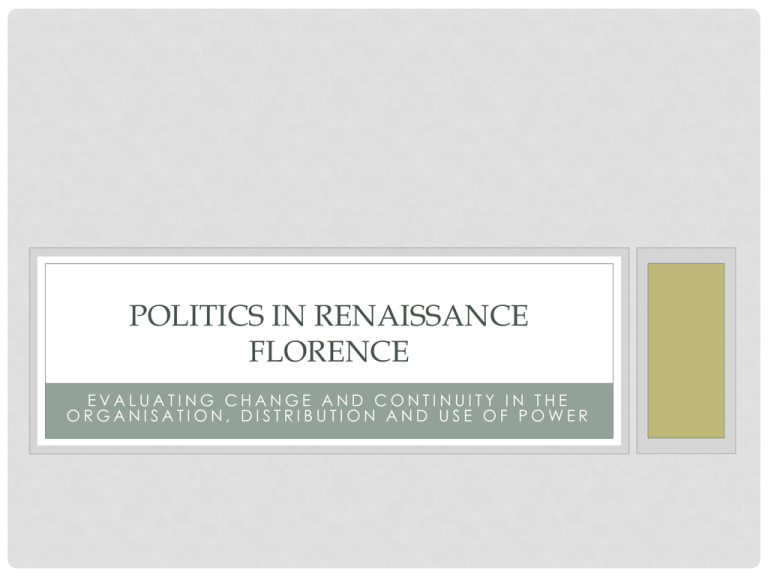
POLITICS IN RENAISSANCE FLORENCE EVALUATING CHANGE AND CONTINUITY IN THE ORGANISATION, DISTRIBUTION AND USE OF POWER WHERE TO BEGIN? • By the end of the C13th virtually all the independent communal governments on the Italian peninsula have been replaced by signores (rule by a lord) Florence’s Republic is not typical. It is a unique exception! A COMPLEX STORY “In Florence men naturally love equality and are therefore very unwilling to accept and recognise others as their superiors. We are by temperament full of strong passions and restlessness, and it is this which is the cause of discord and disunity among the ruling elite. Through their desire to dominate each other, they pull this person here and that one there… The fact that others dislike anyone being superior to themselves ensures that whenever this happens, these men are destroyed.” Dialogue on the government of Florence Francesco Guicciardini UNDERSTANDING POWER From the study design: • Political institutions in Florence • Changes and continuities in the organisation, distribution and use of power in Renaissance Florence from 1293 to 1513 • Focus on Medicean Florence from 1434 to 1494 • Views of the Florentine political system expressed by contemporary writers and historians such as Bruni and Machiavelli 4 PHASES OF POLITICAL DEVELOPMENT • Ordinances of Justice 1293 – 1382 – Guild government • Ciompi Revolt 1382 – 1434 – Merchant Oligarchy • Exile and return of Cosimo De Medici 1434 – 1494 – Medicean dominance • The French invasion and the overthrow of Medici rule 1494 – 1513 – Radical republic • Return of the Medici (with Spanish support) – Dukes of Florence (end of the Republic) KEY - UNDERSTANDING THE CHANGING NATURE OF REPUBLICANISM • Knowing how something is put together is worth a thousand facts about it • The Florentine Republic means different things to different people at different times! Using knowledge to make judgements MAGNATE VIOLENCE AND INTIMIDATION THINK ROMEO & JULIET! NEED FOR STRONG, ACTIVE AND INTRUSIVE GOVERNMENT • Turbulent and violence-prone society • Belief that government should establish order and regulation • Not a community that trusted its members to live in peace and harmony without coercion SECONDO POPOLO (C13TH) • Use of guild militias to take public control of streets and squares • An extensive building program creating new spaces that defined and represented new Republican ideals of participation, liberty and justice. Including the building of the Palazzo della Signoria • The Ordinances of Justice PALAZZO DELLA SIGNORIA & PIAZZA ORDINANCES OF JUSTICE - 1293 1292 - Priorate of Guilds 1293 – Draft of the Ordinances of Justice Two main functions – 1. To exclude and isolate the magnates 2. To give the 21 official guilds of the city complete control over the political process of the Republic LEONARDI BRUNI • As Chancellor of the city he praised Florence as the NEW ROME • His tomb in the Church of Santa Croce was a masterpiece carved in marble • Bruni is represented a lying in state in the toga of a Roman Senator BRUNI • “Those citizens with too great a power of numbers and of force at their command” (=MAGNATES) were excluded from holding public office while “mechanics and members of the lowest class” were not allowed any role in the state (=LABOURING CLASSES). “Thus avoiding the extremes, the city look[ed] to the mean, or rather to the best and the wealthy but not overpowerful”(=CITIZENS/POPOLO who belonged to GUILDS) • Leonardo Bruni (1404) “In praise of Florence” GUILD REPUBLIC WAS NOT A DEMOCRACY Mass in the middle were politically active citizens • Artisans • Shopkeepers • • • • From lesser guilds Merchants Cloth manufacturers Bankers Professionals From greater guilds PARTICIPATION • More than 1000 citizens each year participated in the political process directly by being elected to office • More than 1000 citizens each year assembled as members of the legislative councils • Guild members also participated in politics through • Guild administration • Neighbourhood committees • Confraternities and assemblies linked to local parishes GUILD REPUBLICANISM • Guild members wanted a political voice • That is, decisions and policies formulated by citizens (=guild members) chosen to represent the whole community (=guilds) REPUBLICAN VALUES “Now first of all, great care is taken so that justice is held most sacred in the city, for without justice there can be no city, nor would Florence be even worthy to be called a city. Next there is provision for liberty, without which this great people would not even consider that life was worth living. These two principles are joined (almost as a stamp or goal) to all the institutions and statutes that the Florentine government has created” – Bruni (1404) Panegyric “In praise of Florence” POWER STRUGGLES BETWEEN SOCIAL GROUPS Ottimati – elite families Popolo guilds Popolo minuto – labouring classes THE CIOMPI REVOLT & THE REPUBLIC (1378) “The most striking characteristic of these rebels was their innate conservatism, their respect for tradition, their adherence to the old forms and rituals. Perhaps it would be more accurate to say that , like every other group in Florentine society, the popolo minute accepted the economic system….Neither in the petitions, nor presumably among the Ciompi themselves was there an articulated demand for the destruction of the regime and the establishment of a new egalitarian order. Illustrative of lower-class conservatism was the Ciompi’s acceptance of the constitutional structures under which it had been suppressed and exploited for a century” - Brucker OTTIMATI – DIFFERENT VIEW OF REPUBLICANISM • Emergence of elite families who attempted to dominate the city (Merchant oligarchy) • Resented elements of the popolo after the Ciompi Revolt and limited their involvement in the political process • New avenues to power – personal and family patronage networks • Period of bitter rivalries and factional quarrels that destabilised Florence • Period of successive crises – drained wealth, civil unrest, divided leadership and factionalism THE MEDICI (1434) • One family come to dominate the city • Party/faction of family connections, friends and neighbourhood loyalties • Governed Florence indirectly for 60 years • Ordinary Florentines viewed the Medici as defenders of the city’s Republican values MEDICI ATTITUDE TOWARDS THE REPUBLIC • Concentration of power in the hands of the patriarchs of the Medici family • • • • Political skill Vast wealth Powerful patronage network Ruthless destruction of enemies (exile & exclusion) BUT preserved Republican institutions Najemy – By 1471, the Republic had already become an “empty shell” UNDERSTAND HOW THE MEDICI CHANGED THE REPUBLIC • Maintained but manipulated formal institutions • Use of informal means to consolidate power • Strategies • Use of Balie (commissions with emergency powers) • Manipulation of the accopiatori (committee who managed the electoral process) • Excluded rivals from electoral lists • Replaced independent and foreign magistrates and judges with loyal supporters • Used tax system to destroy enemies and reward friends • Used treason laws to extinguish criticism of the Medici family PATRONAGE • Petitioners appealed to Lorenzo for support and favours Jobs/positions Tax exemptions Criminal sentences Arranging marriages • Business opportunities • • • • CHALLENGES TO MEDICI RULE • Florentine elites never wholly accepted Medici rule and resented domination • In every generation, there was a significant challenge to power (Pazzi conspiracy being the most important) 1479 drawing by Leonardo da Vinci of hanged Pazzi conspirator Bernardo di Bandino Baroncelli LORENZO DE MEDICI “Prince in everything but name” – Pope Pius II Overtly controlled the Republic through – • Manipulation of Republican institutions • Control of the major guilds • Interference in the Church and confraternities RESTORATION OF THE REPUBLIC (1494) • Foreign invasion & Medici rule collapses • Opportunity to restore “liberty, freedom and good government” • Restoration of institutions and structures the Medici dismantled • New Great Council (25% of adult male population eligible for a seat) • Most democratic form of Republicanism for 100 years SAVONAROLA • Firebrand monk who pursued a program of moral and religious reform • Powerful political voice of the new Republic • Bizarre and grizzly end! DISORDER, CHAOS & COLLAPSE • New Republican government ineffective • Government undermined on every side • Climate of anxiety • Weaknesses of the system ruthlessly exposed (writings of Machiavelli) “A PARADISE INHABITED BY DEVILS.” AGNOLO ACCIAIUOLI GOOD LUCK FOR THE REST OF YOUR STUDY!
